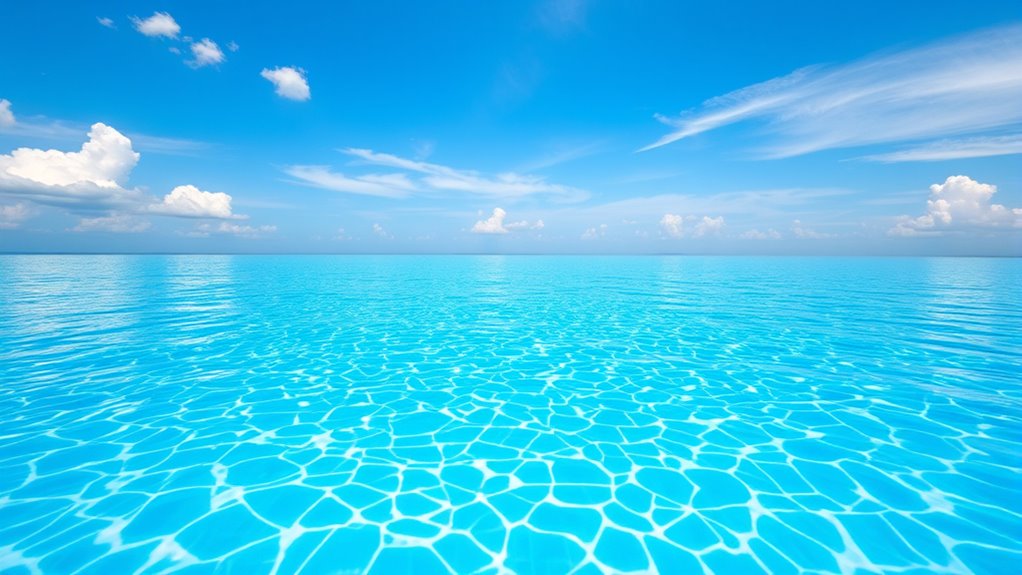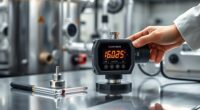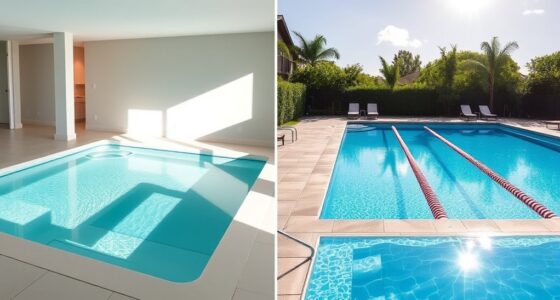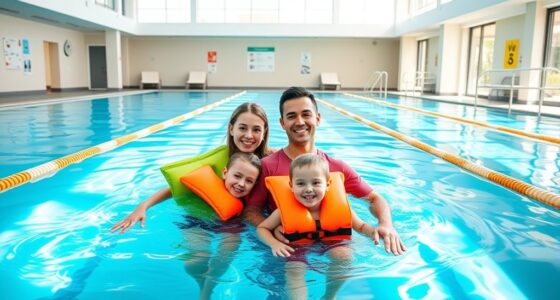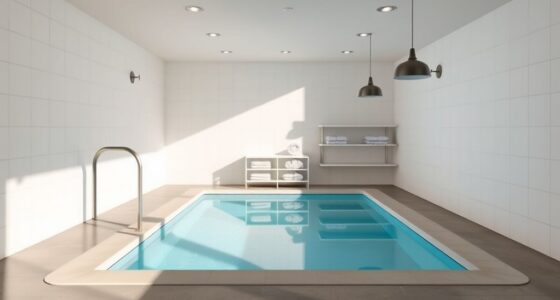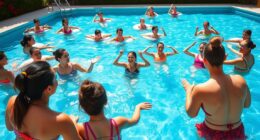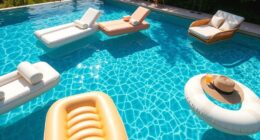To keep your endless pool sparkling clear, focus on balancing your water chemistry. Test regularly for pH (aim for 7.2-7.6), chlorine (1-3 ppm), alkalinity (80-120 ppm), and TDS levels. Adjust chemicals as needed to prevent cloudiness, algae, and bacteria. Routine cleaning, filter checks, and proper sanitation make a big difference. Stay consistent, and you’ll enjoy beautiful, inviting water—if you continue exploring these simple steps, you’ll master pool perfection.
Key Takeaways
- Regularly test pH, chlorine, alkalinity, and TDS levels to maintain balanced water chemistry.
- Keep pH between 7.2 and 7.6 and chlorine at 1-3 ppm for clear, safe water.
- Use appropriate chemicals to correct imbalances promptly, following manufacturer instructions.
- Maintain proper sanitizer levels and perform routine shocking to prevent algae and bacteria growth.
- Clean filters, skim debris daily, and monitor water parameters weekly for optimal clarity.
Understanding Your Pool’s Water Chemistry
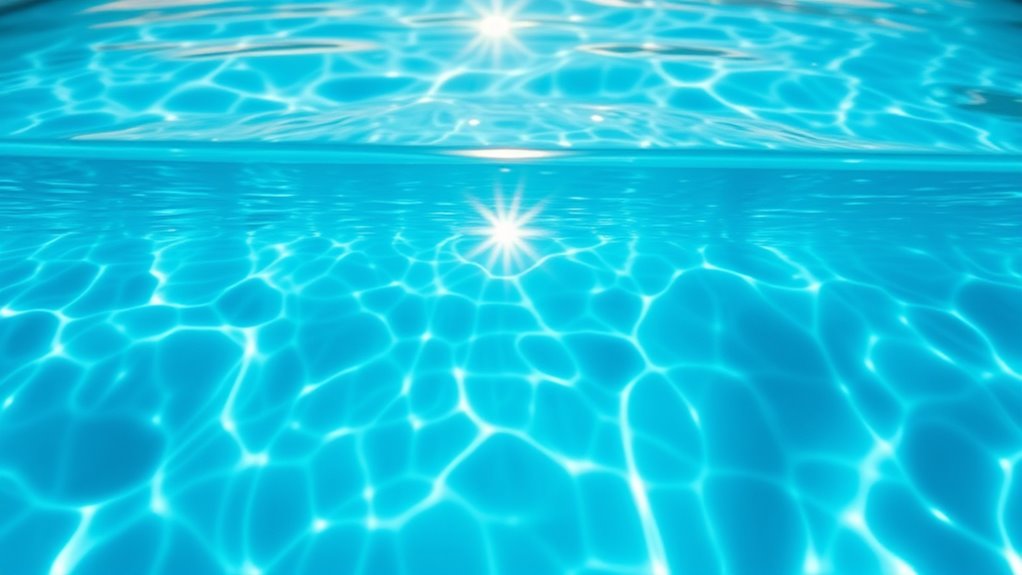
Understanding your pool’s water chemistry is essential for keeping the water safe and inviting. When you know what’s happening beneath the surface, you can prevent problems before they start. Test your water regularly using simple test kits to check for key elements like chlorine, pH, alkalinity, and calcium hardness. These readings tell you if the water is balanced or if adjustments are needed. Keep in mind that each element affects the others, so maintaining proper levels is a balancing act. If you ignore these factors, the water can become cloudy, algae can grow, and bacteria can thrive. For optimal results, consider using a reliable home testing kit to simplify monitoring. By staying on top of your pool’s chemistry, you create a safe, clean environment that’s perfect for swimming and relaxing.
The Importance of Ph Balance and How to Maintain It
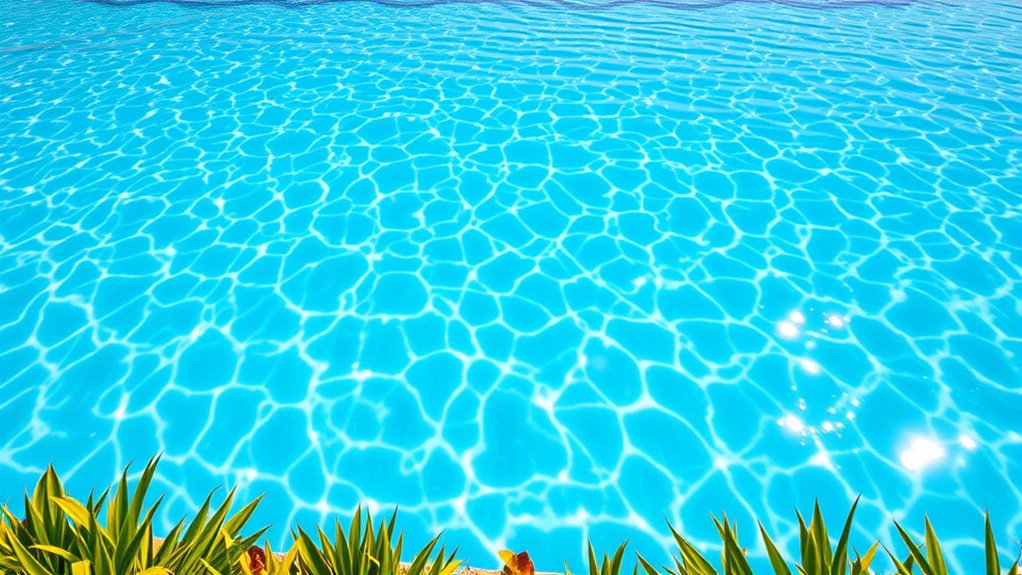
Maintaining the right pH balance is essential for keeping your pool water safe and comfortable. When pH levels are off, your water can become cloudy, corrosive, or harsh on your skin and eyes. Proper pH helps your sanitizer work effectively and protects your pool equipment. To keep things in check, test your water regularly using a reliable test kit. Adjust the pH with simple chemicals like pH increasers or decreasers when necessary. Monitoring and maintaining proper pH also prevents scale buildup and corrosion, extending your pool’s lifespan. Proper pH level is also crucial for ensuring the effectiveness of other pool chemicals and maintaining water clarity.
Sanitizing Your Pool: Options and Best Practices
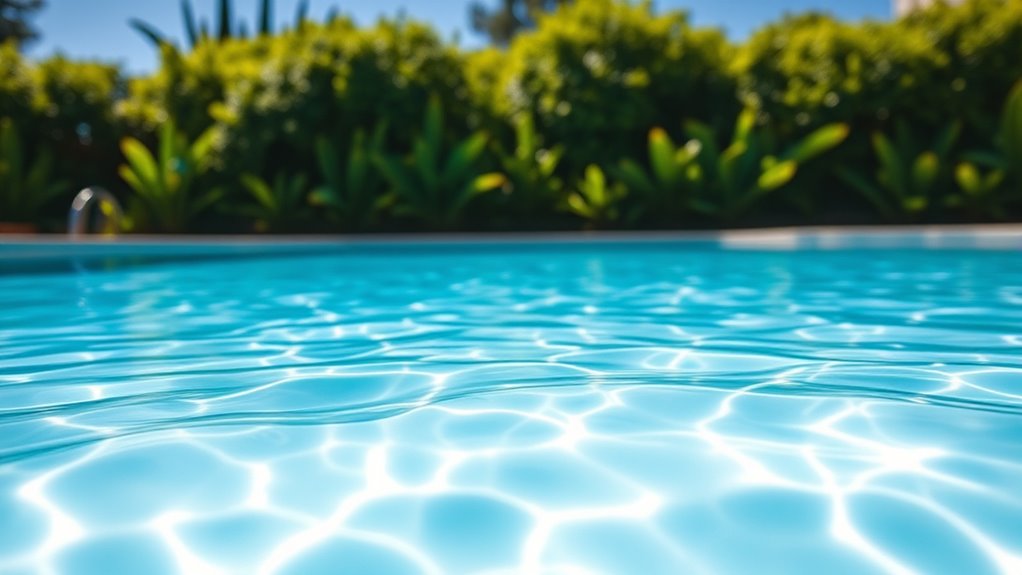
Sanitizing your pool effectively is essential to keep the water safe, clear, and free of harmful bacteria. You have several options, including chlorine, bromine, and salt systems. Chlorine is the most common and affordable choice, quickly killing germs and maintaining water hygiene. Bromine works well in warm water and is less irritating to skin and eyes. Salt systems generate chlorine automatically through electrolysis, providing a continuous, low-maintenance sanitizing method. Whichever option you choose, follow manufacturer instructions carefully and maintain proper levels to prevent algae growth and bacteria buildup. Regularly shocking your pool with a higher dose of sanitizer helps keep the water pristine. Consistency is key—by sticking to a regular sanitizing routine, you’ll ensure your pool remains safe, inviting, and crystal clear. Additionally, understanding your pool’s safe operating levels and monitoring them regularly helps optimize sanitation and prevent issues before they arise.
Monitoring and Adjusting Chlorine Levels
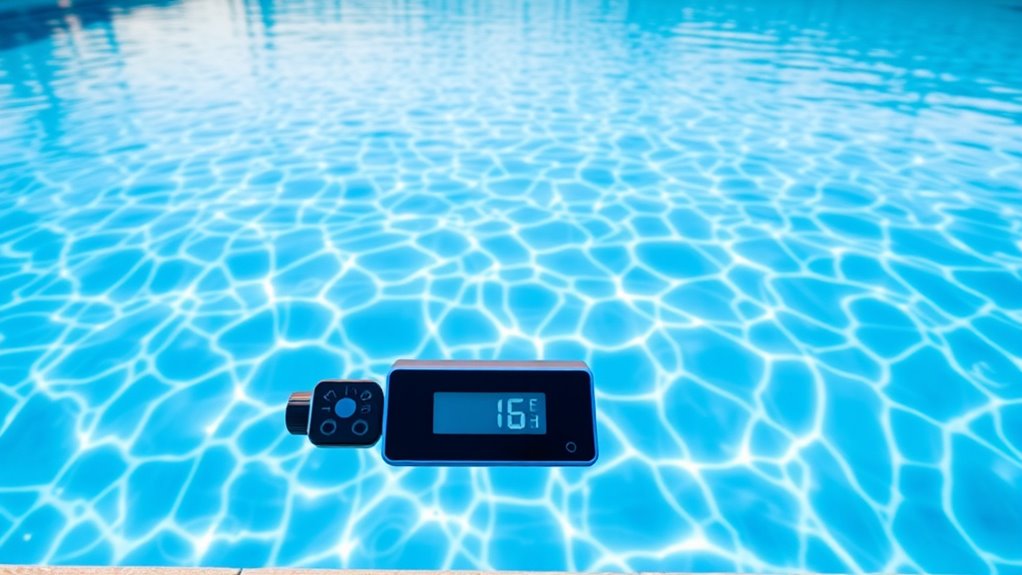
You should test your pool’s chlorine levels regularly to keep the water safe and balanced. Maintaining the ideal range guarantees your pool stays sanitized without overusing chemicals. When needed, adjust the chlorine carefully to keep everything working smoothly. Proper testing ensures accurate readings and prevents issues such as over-chlorination or algae growth for optimal water quality.
Test Chlorine Regularly
To keep your pool safe and clean, maintaining proper chlorine levels regularly is vital. Testing your chlorine often guarantees it stays within the ideal range, preventing bacteria growth and algae. Use test strips or a liquid test kit for quick and accurate results. Check your chlorine levels at least twice a week, especially during hot weather or heavy use. Keep a log of your test results to spot trends and adjust accordingly. Remember, consistent testing helps avoid over-chlorination or insufficient sanitation. Invest in reliable testing tools for ease and accuracy. Regular testing keeps your pool inviting, safe, and sparkling. By staying vigilant, you’ll enjoy crystal-clear water and a healthy swimming environment every time.
Maintain Ideal Levels
Once you’ve tested your chlorine levels regularly, the next step is to maintain them within the ideal range. This ensures your pool stays safe and crystal clear. Keep your chlorine levels between 1 and 3 ppm (parts per million). If levels are too low, algae and bacteria can grow, making your water unsafe. If they’re too high, the water might become irritating or cloudy. Use a chlorine tablet or liquid chlorine to adjust levels as needed. Always add chlorine gradually and wait a few hours before retesting. Consistent monitoring helps you catch fluctuations early, preventing problems before they start. Maintaining proper chlorine levels keeps your pool balanced, safe, and inviting for every swim. Community-driven experimentation in pool chemistry allows enthusiasts to learn from shared experiences and improve water quality management.
Adjust Chlorine Safely
Monitoring chlorine levels regularly is essential to guarantee safe and balanced pool water. When you test your water, you’ll know if the chlorine is too high or too low. To adjust chlorine safely, add small amounts gradually rather than large doses. Always follow the manufacturer’s instructions to prevent overcorrection. Use a reliable test kit to get accurate readings quickly. Remember, maintaining proper chlorine levels helps prevent bacteria and algae growth. If chlorine is low, add sanitizer carefully; if it’s high, let sunlight or filtration reduce it naturally. Keep a log of your tests and adjustments to track trends over time. Staying informed about AI detection methods can help you better understand the technology behind automated testing tools. Stay vigilant, and you’ll enjoy clear, healthy water with minimal risk. Proper monitoring and cautious adjustment protect both your pool and your peace of mind.
Managing Total Dissolved Solids and Alkalinity
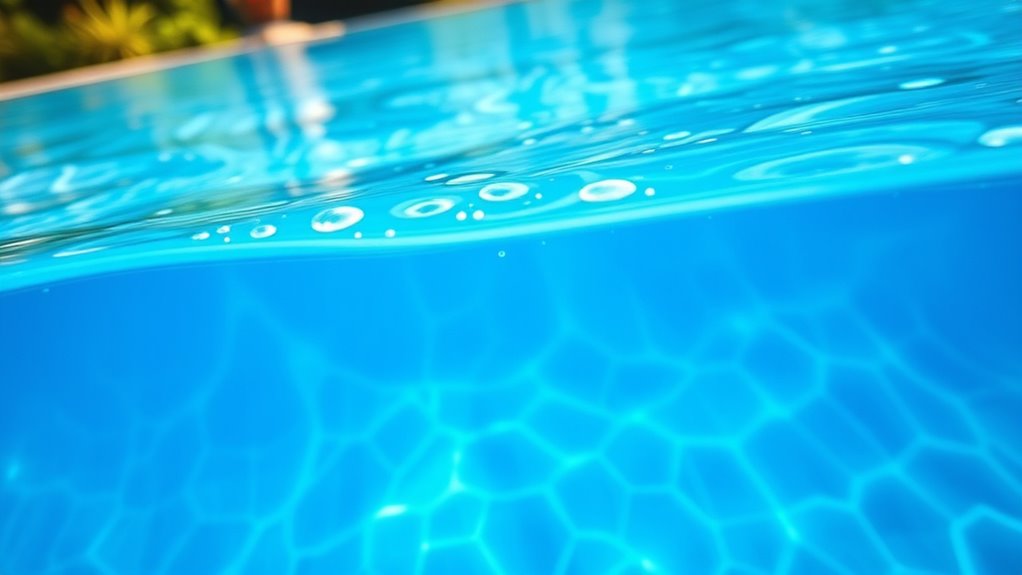
Managing total dissolved solids (TDS) and alkalinity is essential for maintaining a healthy and balanced pool. TDS measures the combined amount of all dissolved substances in your pool water, like minerals and salts. High TDS levels can cause cloudiness, scaling, and reduced sanitizer effectiveness. To keep TDS in check, regularly drain and refill some water, especially if you notice persistent issues. Alkalinity controls your pool’s pH stability, preventing sudden changes that can harm swimmers or damage equipment. Keep alkalinity between 80-120 ppm by adding alkalinity increasers or decreasers as needed. Test both TDS and alkalinity weekly using reliable test kits. Proper management guarantees your water remains clear, safe, and comfortable, while also protecting your pool equipment from buildup and corrosion. Regularly monitoring water chemistry helps prevent filter clogging and extends the lifespan of your pool components.
Tips for Keeping Your Endless Pool Sparkling Clean

Keeping your endless pool sparkling clean starts with regular water testing to catch issues early. Maintaining proper chemical balance prevents algae and bacteria from taking hold. Stick to a consistent cleaning routine to guarantee your pool stays clear and inviting. Regularly checking and replacing your filter ensures optimal water circulation and cleanliness.
Regular Water Testing
How often should you test your pool water to guarantee it stays crystal clear? Ideally, you should check it at least twice a week. Regular testing helps catch imbalances early, preventing cloudy water and algae growth. Keep a water test kit handy for quick checks. When testing, focus on key parameters such as pH, chlorine levels, alkalinity, and stabilizer levels. This habit ensures your pool stays inviting and safe to swim in. Remember, consistency is key to maintaining perfect water quality. Here are some tips to make testing easier:
- Set a weekly schedule for testing
- Keep test kits in a visible spot
- Record your results for trend tracking
- Adjust chemicals as needed based on results
- Understanding pool chemistry is essential for proper maintenance.
Proper Chemical Balance
Regular water testing helps you spot imbalances early, but maintaining proper chemical levels is what keeps your endless pool sparkling. You want the pH balanced between 7.2 and 7.6 to prevent skin irritation and equipment damage. Use test strips or a liquid test kit regularly to check levels. If the pH is too high, add a pH reducer; if too low, add a pH increaser. Chlorine or bromine levels should stay between 1 and 3 ppm to effectively sanitize the water. Always follow manufacturer instructions when adding chemicals. Consistent monitoring and adjustments keep algae, bacteria, and cloudy water at bay. Proper chemical levels also help prevent Narcissistic Manipulation that can disrupt your pool maintenance routine. When your chemical levels are balanced, your pool remains inviting, safe, and crystal clear for every swim.
Consistent Cleaning Routine
Ever wonder what it takes to keep your endless pool consistently sparkling? The secret is a simple, regular cleaning routine. Staying on top of maintenance prevents buildup and keeps the water crystal clear. First, skimming the surface daily removes leaves and debris. Second, vacuum the bottom weekly to eliminate dirt that sinks. Third, wipe down the sides monthly to prevent algae and grime. Ultimately, check your filter regularly and clean or replace it as needed. Consistency is key—skipping routine cleaning can lead to cloudy water and potential damage. By sticking to these easy steps, you’ll maintain a pristine, inviting pool that’s ready whenever you are. Keep your pool in top shape with these simple habits, and you’ll enjoy sparkling water all season long.
Frequently Asked Questions
How Often Should I Test My Pool Water?
You should test your pool water at least twice a week to maintain ideal clarity and safety. If you notice any changes, like cloudiness or strong odors, test more frequently. Use a reliable test kit to check pH, chlorine levels, and alkalinity. Regular testing helps you catch imbalances early, so you can add chemicals as needed and keep your pool water crystal clear and safe for swimming.
Can Natural Methods Replace Chemical Sanitizers?
Natural methods can’t fully replace chemical sanitizers, but they can supplement your pool maintenance. You can use options like UV sanitizers, ozone systems, or mineral filters to reduce chemical use. However, these methods alone often don’t provide complete sanitation, so you’ll still need some chemicals like chlorine or bromine to keep the water safe and clear. Combining natural methods with proper chemical balance is the best way to maintain a healthy pool.
What Are Signs of Imbalance in My Pool Water?
You’ll notice signs of imbalance in your pool water when it appears cloudy, has a strong chlorine or chemical odor, or causes skin and eye irritation. If you see algae growth, metal stains, or if the pH and alkalinity levels are off, these are clear indicators. Regular testing helps catch these issues early. Keep your water balanced by adjusting chemicals promptly to maintain clarity, safety, and comfort.
How Do Weather Changes Affect Pool Chemistry?
Weather changes can substantially impact your pool chemistry. Hot, sunny days cause the water to evaporate faster, concentrating chemicals and raising pH levels. Rainfall can dilute your pool’s chemicals, lowering sanitizer levels and introducing debris. Wind can stir up dirt and debris, affecting clarity. You’ll need to test your water more frequently during weather shifts and adjust chemicals accordingly to maintain balanced, clear water.
Is It Necessary to Drain and Refill My Pool Regularly?
You don’t always need to drain and refill your pool regularly. Instead, focus on proper maintenance—test the water often, adjust chemicals as needed, and skim debris. Draining is usually only necessary when water becomes heavily contaminated or chemical balance can’t be restored. By maintaining your pool properly, you can keep the water crystal clear without frequent draining, saving time and resources while ensuring a safe, inviting swimming environment.
Conclusion
Now you’re armed with pool chemistry secrets that could turn your endless pool into a crystal-clear oasis—no wizardry required. Just imagine a sparkling surface so pristine it mirrors the sky, all thanks to your newfound expertise. Forget Neptune’s magic; your pool’s clarity depends on your vigilance, not mythical powers. plunge in confidently, knowing that with a little effort, you’ll be the envy of every mermaid and merman in town—no underwater wizardry needed.
